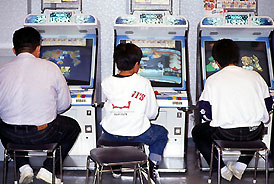Old Boy Volume 1

Rarely does a first volume explode out of the gates like Old Boy. From the opening pages we are sucked into the cool and mysterious story of ... what IS his name?
Our story opens as Old Boy, as we'll call him, is broken out of a mysterious apartment/prison where is has been held for ten years. But who are the Mafioso looking guys who broke him out?... and more importantly, why? Old Boy soon discovers that keeping himself in shape while incarcerated was a good idea, as he handles a group of young punks who try to rob him with relative ease. Taking enough money from them for a decent meal, he meets the beautiful young Eri, who is kind enough to give him shelter for the night. Old Boy needs to get his life back together, but there is something about revenge that can keep a man so preoccupied.
Any attempt to put down Old Boy Volume 1 mid-read should be made at your own risk. This is a fast-paced and fascinating story, told partially in flashbacks, revealing bits and pieces one juicy morsel at a time. Some things the reader finds out that Old Boy doesn't know, and Old Boy certainly hasn't revealed all his cards yet, too. The style of Old Boy is very crisp and new. Unlike some manga where every character looks the same, where the hero is the tall handsome blonde guy, and the villain is the tall handsome dark-haired guy, Old Boy's look is more unique and ambiguous. Every character has a distinct look, (the title character, especially), yet looks don't tell us immediately who is a bad gu, and who is a good guy, which makes sense for this twisted story. Old Boy himself is cool, but not too handsome, and definitely rough around the edges. Nobuaki Minegishi's art is detailed yet smooth. The drawings are angular and tense. The several scenes of cityscapes are incredibly intricate, and give a real sense of the size of Tokyo, how big the buildings are, and how far the sprawl goes. This is a nice contrast to the claustrophobic nature of the little room Old Boy was stuck in for those ten long years.
The style of Old Boy is very crisp and new. Unlike some manga where every character looks the same, where the hero is the tall handsome blonde guy, and the villain is the tall handsome dark-haired guy, Old Boy's look is more unique and ambiguous. Every character has a distinct look, (the title character, especially), yet looks don't tell us immediately who is a bad gu, and who is a good guy, which makes sense for this twisted story. Old Boy himself is cool, but not too handsome, and definitely rough around the edges. Nobuaki Minegishi's art is detailed yet smooth. The drawings are angular and tense. The several scenes of cityscapes are incredibly intricate, and give a real sense of the size of Tokyo, how big the buildings are, and how far the sprawl goes. This is a nice contrast to the claustrophobic nature of the little room Old Boy was stuck in for those ten long years.
This manga was the inspiration for the awesome Chan-wook Park movie of the same name released in 2003, but read the manga first, before watching the movie...the twists are worth the wait. This manga is intended for mature readers. Old Boy is an intense and breathtaking debut, and should make out to be a sensational series. Old Boy Volume 2 is released on September 27, 2006. Look here for more reviews on future releases of Old Boy.
This manga is intended for mature readers. Old Boy is an intense and breathtaking debut, and should make out to be a sensational series. Old Boy Volume 2 is released on September 27, 2006. Look here for more reviews on future releases of Old Boy.
















